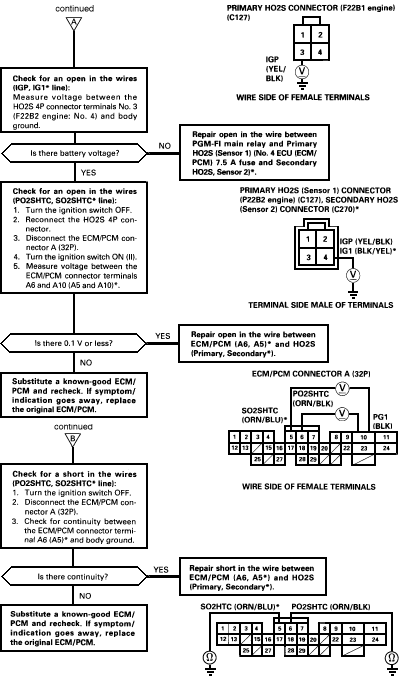I recently fixed a persistent problem with my 90 Honda Accord EX with a F22A4 motor, that the oxygen sensor heater circuit was malfunctioning and throwing a “check engine” code #41, causing poor fuel economy. Here is how to troubleshoot this problem.
When you have a “check engine light” (CEL), the code can be determined by using an alligator clip to jumper the pins inside the blue connector behind the passenger kick panel. There will be a series of long blinks and then short blinks to indicate the respective digits of the code.
A code 41 indicates a fault with the O2 sensor heater. This circuit uses electrical power to preheat the O2 sensor element so that it can start to provide accurate downstream mix information more quickly. Without the heater, the car would take longer to “warm up” and reach optimum performance and fuel economy. While this would be tolerable if it were the only symptom, another problem is that the ECU defaults the fuel mix if any code is thrown, resulting in poor fuel economy even at normal operating temperature if the heater circuit malfunctions.
At first, the code was only thrown occasionally, and then became more consistent over time. I replaced the OEM NTK O2 sensor with a Bosch unit, and then a Denso, with no effect. (The correct way to remove and install an O2 sensor is to heat up the engine and use a special O2 sensor crow’s foot socket, to avoid stripping the threads from the exhaust pipe, and to install the new sensor with anti-seize compound and while the pipe is still hot.)
I was told by experienced Honda techs that the Bosch unit would not work correctly, while the Denso was OEM equipment and should have been fine. Comparing the two units, I measured the resistance on the Bosch unit’s heater wires (4 ohms) and the Denso unit’s (11 ohms). Since the Honda specification is that the heater circuit should be between 10 and 40 ohms, it seemed logical that the Bosch was out of spec. Unfortunately, the Denso did not clear up the problem either.
I checked the voltage on the heater wires at the O2 sensor plug with the key on, and there was 12 volts, so the sensor seemed to be getting the correct power.
I obtained another used ECU from the same model year and installed it, with no improvement in the code. (However, I took this opportunity to repair leaking capacitors and burned resistors in my automatic transmission computer (TCU) as well, a common Accord problem.)
I then unplugged the O2 sensor plug and cleaned it out with carb cleaner since it had quite a bit of grime built up in it, being so close to the axles and the road. I also used CRC electrical contact cleaner, a light solvent and lubricant, to clean out the plugs at the top of the passenger side strut tower to which the O2 sensor wires are routed. No effect.
At some point I checked the voltage at the plug again and found it to be zero. This told me that I either had a bad replacement ECU, or that I was previously suffering from an intermittent wiring fault that had now gone permanent. Which in this case is fortunate, because I finally was able to nail down the problem and fix it.
I next checked the voltage at the HTCNTL pin on the ECU. 12 volts. Then I found the pair of orange wire with black stripe and yellow wire with black stripe in the passenger side strut tower electrical plug closest to the engine. I tested the voltage on the appropriate pins and had 12 volts there too. I went back and checked the O2 plug and it was 0 volts. This told me that the wiring problem was in between the strut tower plug and the sensor plug.
From there I tested my theory by cutting and using wire-nuts to run some temporary wire to the O2 sensor. I was able to run the engine without a CEL coming on. The next night, I used 16 gauge stranded wire, a soldering iron, and heat shrink tube to run a new pair of wires from the strut tower plug down behind the intake manifold to the O2 sensor and, since I did not have room to repair the existing O2 sensor plug, I soldered the wires directly to the ones coming out of the new O2 sensor. (Remember to put heat shrink tube on wires BEFORE soldering)
The result was that the car started and ran without a CEL. Success!
Attached are several diagrams that were helpful to me and not found in the Haynes manual.




[…] isn't then I guess its a faulty ECU or bad wire. If there is, then I'm really stuck. I just found this webpage about similar issue with a Honda Accord. Gives me some good ideas about checking wiring and stuff. […]
[…] Repair Honda Accord code 41 – O2 sensor heater circuit « synaesthesia that should help you out…. i just had the same problem… im just beginning to fix it myself. my pic thread | my Flickr photostream | I My camera and my bike | Currently Driving CL1R 2002 Reply With Quote […]
Thanks for the info. Mine is still intermittent but finally got the plugs separated (what a pain) and everything looked OK.
Voltage was good, O2 ohms reading low but plugged every thing back up and NO CEL!
Wait and see!
Some people just don’t understand when a PCM says there is a fault with some sensor, it doesn’t mean the sensor is bad. Well done man & thanks for the pics.